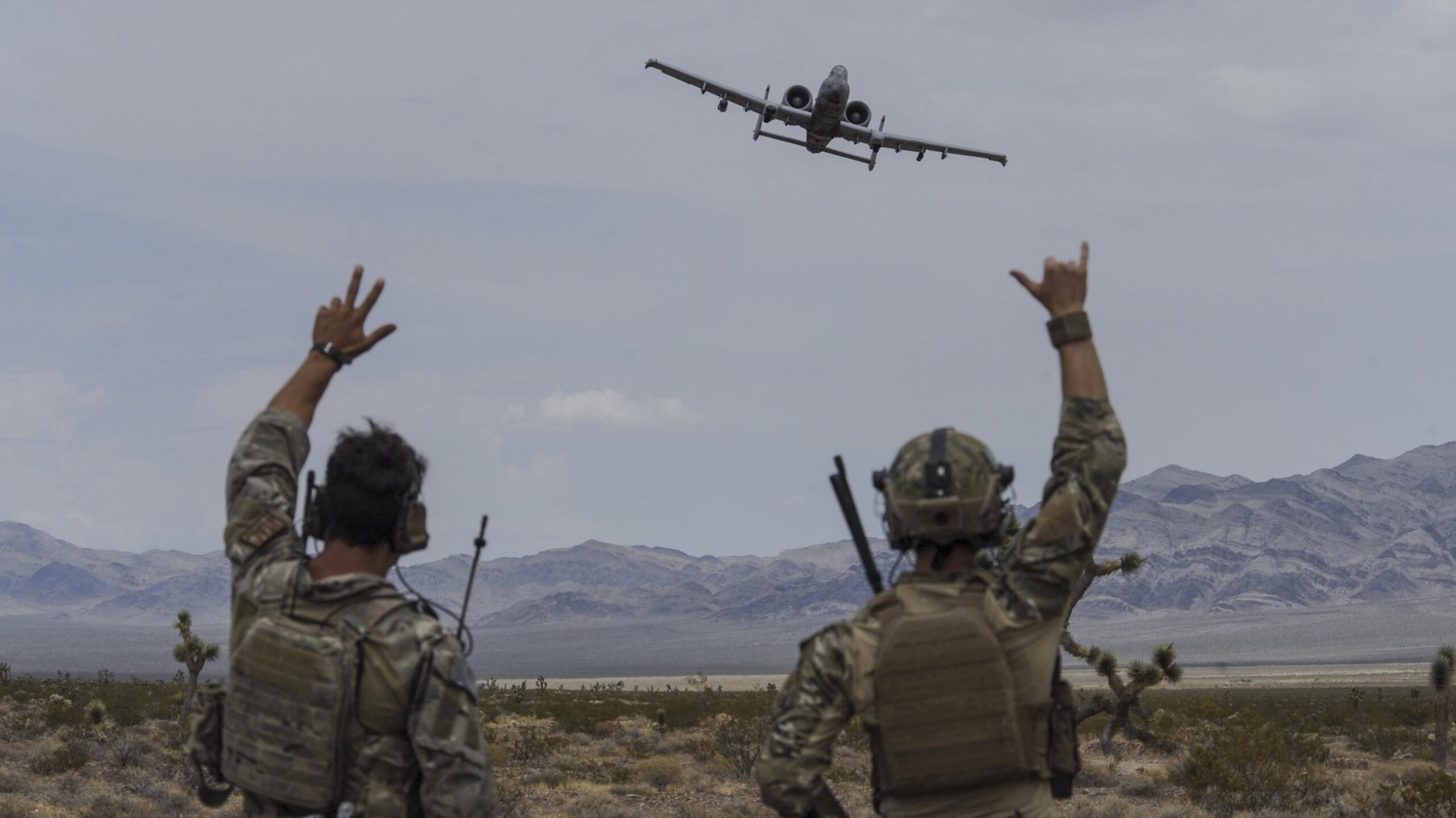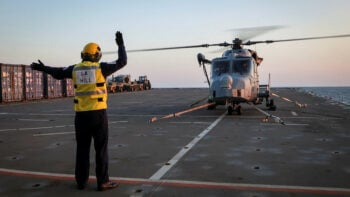
The B-21 Raider at Northrop Grumman’s facilities in Palmdale, Calif. (US Air Force photo.)
WASHINGTON — The US Air Force will request a total of $188.1 billion in the 2025 fiscal year, part of a budget submission that asks lawmakers to greenlight the retirement of 250 aircraft, officials revealed today.
In a Friday briefing with reporters ahead of the budget release, Kristyn Jones, who is performing the duties of the Air Force Undersecretary, said that the service’s budget would grow by about 1.6% compared to the FY24 request of $185.1 billion, an increase of $3 billion. For the Department of the Air Force (DAF), which includes the Space Force, the DAF’s topline would grow from from $215.1 billion in FY24 to $217.5 billion in FY25, an increase of about 1.1%.
“We’re very, very fixated on being competitive with the pacing challenge [of China],” Air Force Secretary Frank Kendall told reporters during the Friday briefing. “I think the budget that we’ve submitted moves us forward — not quite as fast as we would like to, but it moves us forward in the right direction while maintaining the current capabilities that are essential to the nation. So I’m pretty comfortable with what we’re asking for, given the constraints that we have.”
Under spending limits imposed by Congress through the Fiscal Responsibility Act (FRA), total defense spending was capped at $886 billion in FY24 and $895 billion in FY25. Those numbers forced tough trade offs, officials said, curtailing some modernization plans like efforts to replenish aging fighters. Air Force supporters are also quick to point out the service’s budget is actually smaller than portrayed, as $45.1 billion in the DAF’s budget is included for passthrough, or “non-blue” spending that is charged to the Air Force but goes to agencies outside the Pentagon. (Including the passthrough spending, the DAF’s total FY25 budget request is $262.6 billion.)
For more coverage of the FY25 budget release, click here.
According to Kendall, officials strived to protect funding for his seven operational imperatives aimed at countering China, though many-space related imperatives could see a relative slowdown due to fiscal limits.
Though service leaders have telegraphed for months that the FRA would force them to pare back spending plans, growth of just over one percent is unlikely to satisfy hawks eager to see the Pentagon’s topline rise above the rate of inflation, particularly as China sharpens its military prowess. Further spending outside those caps could be possible through a supplemental package, though one championed by the Biden administration is, like the FY24 request itself, currently in limbo on Capitol Hill.
Procurement: Fewer Fighters, More Missiles and No ARRW
The Air Force’s procurement account is one of the most noticeable areas to take a hit under the FRA caps, dropping from a requested $30.6 billion in FY24 to $29 billion in FY25. Those funds, officials say, will buy a total of 90 aircraft, as well as a range of munitions and other equipment.
In addition to procuring a total of 60 fighter jets — 42 F-35As and 18 F-15EXs — the service will seek to continue acquisition of Boeing’s KC-46A refueling aircraft, asking lawmakers for $3.1 billion to buy 15 tankers. After approving production last year, officials will also move forward with procurement of eight Boeing MH-139s, which will patrol the service’s sprawling ICBM silos, although the service preview did not provide a budget figure for these helicopters. Seven Boeing T-7A trainers would also be procured at the cost of $233 million.
About $353 million is also being requested to continue low-rate initial production of one of the service’s highest priorities, the B-21 Raider stealth bomber. The Raider’s engineering and manufacturing development phase will also continue in tandem, which would entail about $2.7 billion in research and development money.
RELATED: Northrop Grumman logs billion-dollar charge on B-21 stealth bomber
Multi-year procurements would continue for key munitions — $825 million for 550 Joint-Air-to-Surface Standoff Missiles (JASSM) and $166 million for 115 Long Range Anti-Ship Missiles (LRASM) — along with $131 million for 128 Advanced Anti-Radiation Guided Missile, Extended Range (AARGM-ER) weapons. A multi-year procurement strategy for Advanced Medium Range Air-to-Air Missiles (AMRAAM) would also continue, though a dollar figure for the 462 missiles requested in the FY25 budget was not immediately available.
The Air Force is buying the AARGM-ER until its new Stand-in Attack Weapon missile comes online, which Air Force Deputy Assistant Secretary for Budget Maj. Gen. Michael Greiner told reporters the service wants to start producing in 2027. Similarly, the service is also moving forward to buy 50 Joint Strike Missiles, which Greiner told reporters last year would serve as an interim capability until LRASM production ramps up. AMRAAM is further an interim buy until its successor, the Joint Advanced Tactical Missile (JATM), can be produced in large quantities.
However, Greiner said the requested multi-year purchases are predicated on Congress approving previous proposed multi-year buys beginning in FY24, and whose outcomes are uncertain until the FY24 appropriations are finalized. Should lawmakers reject the move, the service won’t be able to leverage as great of an economy of scale, which Greiner said could have an impact on the final quantity.
After some seemingly mixed signals from officials, the fate of what could have been the Air Force’s first hypersonic weapon is now more clear. Although a key test still remains, whose results officials said will inform future investment decisions, no funds are being put toward buying the Air-Launched Rapid Response Weapon (ARRW) in FY25.

Air Force JTACs (Joint Terminal Attack Controllers) wave to an A-10 during training. (US Air Force photo)
Flying Into The Sunset
Similar to last year, the Air Force is seeking a raft of divestments to free up funds from maintaining aircraft officials argue are no longer capable of performing in a peer fight. That money, officials say, could be better spent on paving the way to newer replacements.
Epitomizing that view is divestment of the A-10 Warthog, which lawmakers protected against for years before relenting in FY23. After gaining approval for 42 retirements last year, the service now seeks 56 additional retirements, keeping with a goal to clear out the inventory before the end of the decade.
Another key divestment priority are older F-22 Raptors known as Block 20 aircraft. Though Congress has previously blocked the move, the service will once again try to divest 32 of the combat jets in FY25. Divesting those jets will free up funds for other initiatives like its replacement, the Next Generation Air Dominance (NGAD) fighter, and modernizing other F-22s to bridge the way to NGAD.
The total list of the 250 retirements the service is seeking in FY25 is as follows:
- 32 F-22s
- 26 F-15Es
- 11 F-16C/Ds
- 65 F-15C/Ds
- 56 A-10s
- 22 T-1As
- 12 HH-60Gs
- 6 C-130Hs
- 1 EC-130H
- 2 CV-22s
- 1 E-11
- 16 KC-135s
Lawmakers approved many of the service’s 310 requested divestments in FY24 while blocking some others, though the final results for many platforms may not be clear until Congress approves the FY24 budget.
R&D Dollars
In total, the Air Force plans to request about $37.7 billion for R&D, about $1.5 billion more than the FY24 request of $36.2 billion.
To field a new generation of airpower, the Air Force wants to spend big on the “family of systems” underpinning NGAD technologies, asking for a total of nearly $3.4 billion for the effort. That includes about $2.8 billion for the NGAD platform and approximately $680 million for the Collaborative Combat Aircraft (CCA) drone wingman program — $560 million for the drones themselves and another $120 million for other related CCA work like autonomy development. An award for NGAD, assumed to be either Boeing or Lockheed Martin, is expected this calendar year.
According to an Air Force spokesperson, that CCA money will be geared toward building production representative drones and proceeding with a test campaign. As Breaking Defense first reported, five companies — Anduril, Boeing, General Atomics Aeronautical Systems, Lockheed Martin and Northrop Grumman — were selected by the Air Force for an early stage of the CCA program, which officials recently said will soon eliminate two or three vendors. The FY25 money will additionally kick off early work for a second, parallel CCA development program for a separate tranche of drones.
Research on other key initiatives will continue, like the Hypersonic Attack Cruise Missile (HACM) that top officials like Kendall have suggested they are “more committed” to than ARRW. The service will request about $517 million for HACM, as well as $623 million for a new nuclear-armed cruise missile known as the Long Range Stand Off (LRSO) weapon.
An effort to field a replacement for the E-4B Nightwatch “doomsday plane” would also see a jump in funding to $1.7 billion, up from $900 million in FY24. After Boeing was eliminated from contention for the program, all eyes are on Sierra Nevada Corp. as the only publicly known contender that remains. The award for that program is expected this calendar year.
Separately, the DAF will continue building out its “Battle Network” concept, the department’s contribution to the Pentagon’s larger Combined Joint All Domain Command and Control (CJADC2) initiative. The Air Force is requesting nearly $750 million within the Advanced Battle Management System funding line, which a service spokesperson said will furnish four key initiatives: architecture and systems engineering, digital infrastructure, software and applications, and aerial networking. The last of those four will include an edge node prototype demonstration on the KC-46A and similar prototyping work on the F-15EX.

US Air Force artist’s rendering of the Sentinel in flight. (US Air Force photo)
O&M, MILPERS And MILCON Costs, With Sentinel Looming
For the Air Force’s people-related expenses, the service plans to request about $75.6 billion for operations and maintenance (O&M), $41.7 billion for military personnel (MILPERS), and $4.1 billion for military construction projects (MILCON). According to Greiner, funding increases would facilitate about a 4.5% pay raise for airmen, a 4.2% increase in housing allowance and a 3.4% bump in subsistence payments. A civilian pay raise of about 2% would also be funded.
About $538 million is included for the Air Force’s agile combat employment (ACE) initiative — an effort to make operations more resilient to better counter attacks on installations, particularly in the Indo-Pacific — though that number is about half what the Air Force requested for ACE in FY24. Another $700 million will also fund military construction for the Sentinel ICBM, where unforeseen challenges in refurbishing silos and building out requisite infrastructure prompted a critical cost breach for the program.
Currently under a congressionally-mandated review by the Defense Secretary, officials have already vowed to pay whatever it takes to move Sentinel forward. That effect will likely be felt in FY26, Jones told reporters, prompting difficult decisions amid other pressing modernization goals.
“We’ve got some tough choices ahead when we get into ‘26, which we’re really building now,” Kendall said.






















